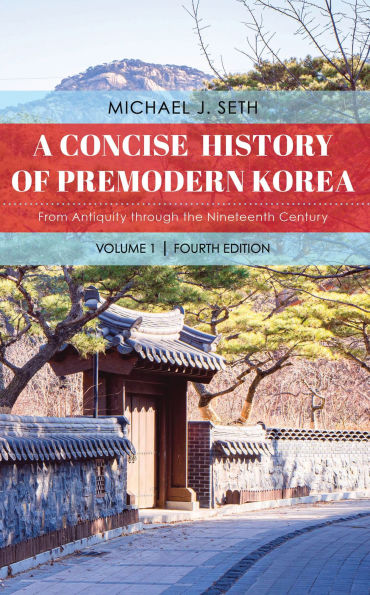Michael Seth’s text remains the most accessible overview of Korean history. Going beyond the platitudes about the ‘land of the morning calm’ or the ‘hermit kingdom,’ it is a useful and clear guide to the Korean peninsula’s turbulent past.
Michael Seth’s A Concise History of Korea remains the best overview of Korean history in the English language. Both thorough and readable, it is the ideal book to use in undergraduate-level Korean history courses. It is also great for anybody who wants to know more about almost any aspect of Korean history.
Whenever I'm asked to recommend a textbook on Korean history, I always put Michael Seth’s A Concise History of Korea at the top of my list. Now in its third edition, the book provides the most up-to-date survey of Korean history, introducing fresh research and interpretations. Seth places Korea clearly within the East Asian world and highlights the unique aspects of Korea’s past. As with the previous edition, Michael Seth succeeds in this history in every way.
Michael Seth's text remains the most accessible overview of Korean history. Going beyond the platitudes about the 'land of the morning calm' or the 'hermit kingdom, ' it is a useful and clear guide to the Korean peninsula's turbulent past.
Michael Seth's A Concise History of Korea remains the best overview of Korean history in the English language. Both thorough and readable, it is the ideal book to use in undergraduate-level Korean history courses. It is also great for anybody who wants to know more about almost any aspect of Korean history.
Whenever I'm asked to recommend a textbook on Korean history, I always put Michael Seth's A Concise History of Korea at the top of my list. Now in its third edition, the book provides the most up-to-date survey of Korean history, introducing fresh research and interpretations. Seth places Korea clearly within the East Asian world and highlights the unique aspects of Korea's past. As with the previous edition, Michael Seth succeeds in this history in every way.
The second edition of Korea expert Seth’s two-volume work provides an extremely dense history of Korea from antiquity to the present, focusing on economic and state or national formation. The first volume, subtitled From Antiquity through the Late Nineteenth Century, includes more information on art, literature, religion, and philosophy than the second volume, subtitled From the Late Nineteenth Century to the Present, but both would have benefited from illustrations beyond the maps provided before the introductions, particularly in chapters 7 and 8 of the first volume. Whether exploring the rise and influence of Buddhism and Confucianism on the Korean people as they developed a homogeneous society or illuminating the distinctions between the arbitrarily divided peninsula into the radically divergent ‘lifestyles and living standards’ separating North and South Korea, Seth provides a tremendous amount of material within a few succinct paragraphs. The title a ‘concise history’ is quite apt, and Seth’s writing style and use of sources ensures the work a prominent place within the historiography, particularly for undergraduates. Both volumes benefit from revisions from the first edition that reflect the rapid development of Korean historical understanding in the West along with chapter essays on Korea in global perspective, which focus on specific issues of economic development: state formation and ideology in its many forms, foreign policy from antiquity to the present in East Asia, imperialism and colonialism, education and meritocracy, and warfare. Seth also includes a selection of primary source extracts relating to ideas or individuals discussed at the end of each chapter. Excellent maps in both volumes, appendixes providing information on Romanization, a glossary of Korean words, and an annotated select bibliography. Good use of chapter notes.
Summing Up: Highly recommended. All undergraduate and graduate collections.
Michael Seth's book provides a clear and accessible survey of Korean history, deftly covering all of the key topics that should be included in a course on the subject. I would highly recommend it to anybody looking to gain a stronger understanding of the historical development of Korea.
The second edition of Korea expert Seth’s two-volume work provides an extremely dense history of Korea from antiquity to the present, focusing on economic and state or national formation. The first volume, subtitled From Antiquity through the Late Nineteenth Century, includes more information on art, literature, religion, and philosophy than the second volume, subtitled From the Late Nineteenth Century to the Present, but both would have benefited from illustrations beyond the maps provided before the introductions, particularly in chapters 7 and 8 of the first volume. Whether exploring the rise and influence of Buddhism and Confucianism on the Korean people as they developed a homogeneous society or illuminating the distinctions between the arbitrarily divided peninsula into the radically divergent ‘lifestyles and living standards’ separating North and South Korea, Seth provides a tremendous amount of material within a few succinct paragraphs. The title a ‘concise history’ is quite apt, and Seth’s writing style and use of sources ensures the work a prominent place within the historiography, particularly for undergraduates. Both volumes benefit from revisions from the first edition that reflect the rapid development of Korean historical understanding in the West along with chapter essays on Korea in global perspective, which focus on specific issues of economic development: state formation and ideology in its many forms, foreign policy from antiquity to the present in East Asia, imperialism and colonialism, education and meritocracy, and warfare. Seth also includes a selection of primary source extracts relating to ideas or individuals discussed at the end of each chapter. Excellent maps in both volumes, appendixes providing information on Romanization, a glossary of Korean words, and an annotated select bibliography. Good use of chapter notes.
Summing Up: Highly recommended. All undergraduate and graduate collections.



